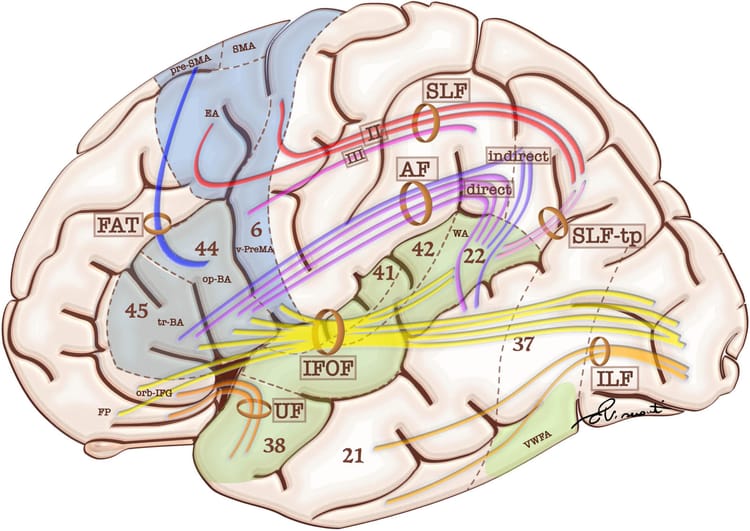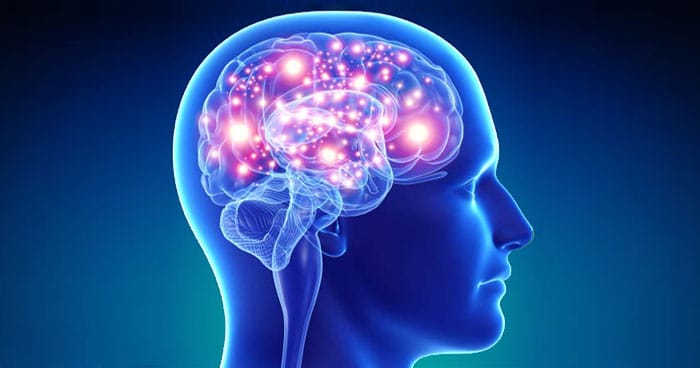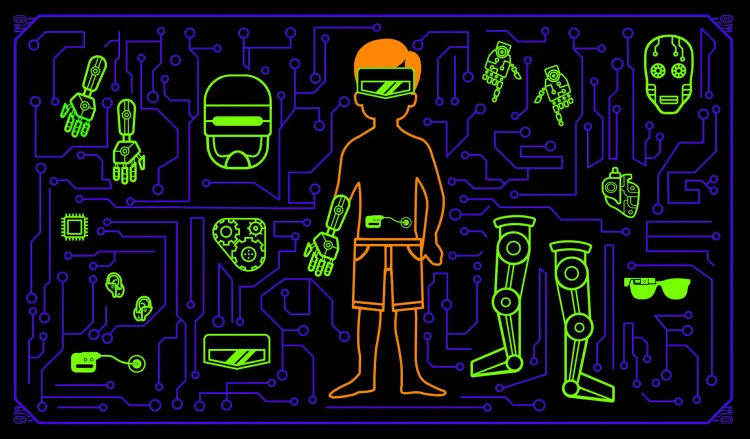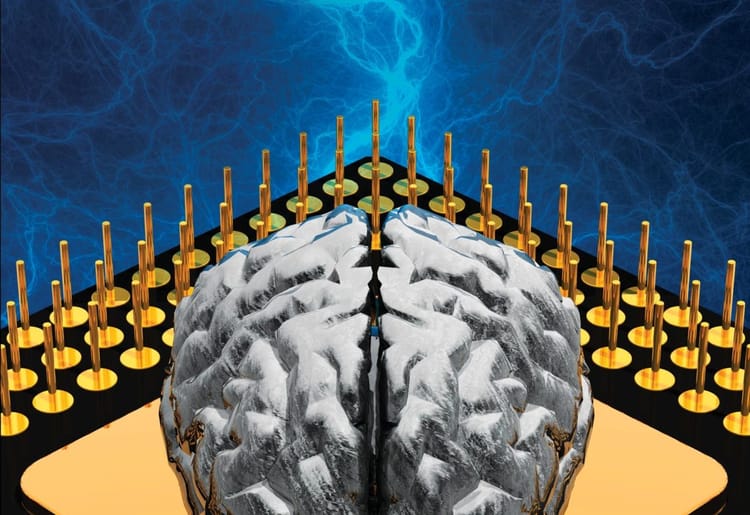Inside Out
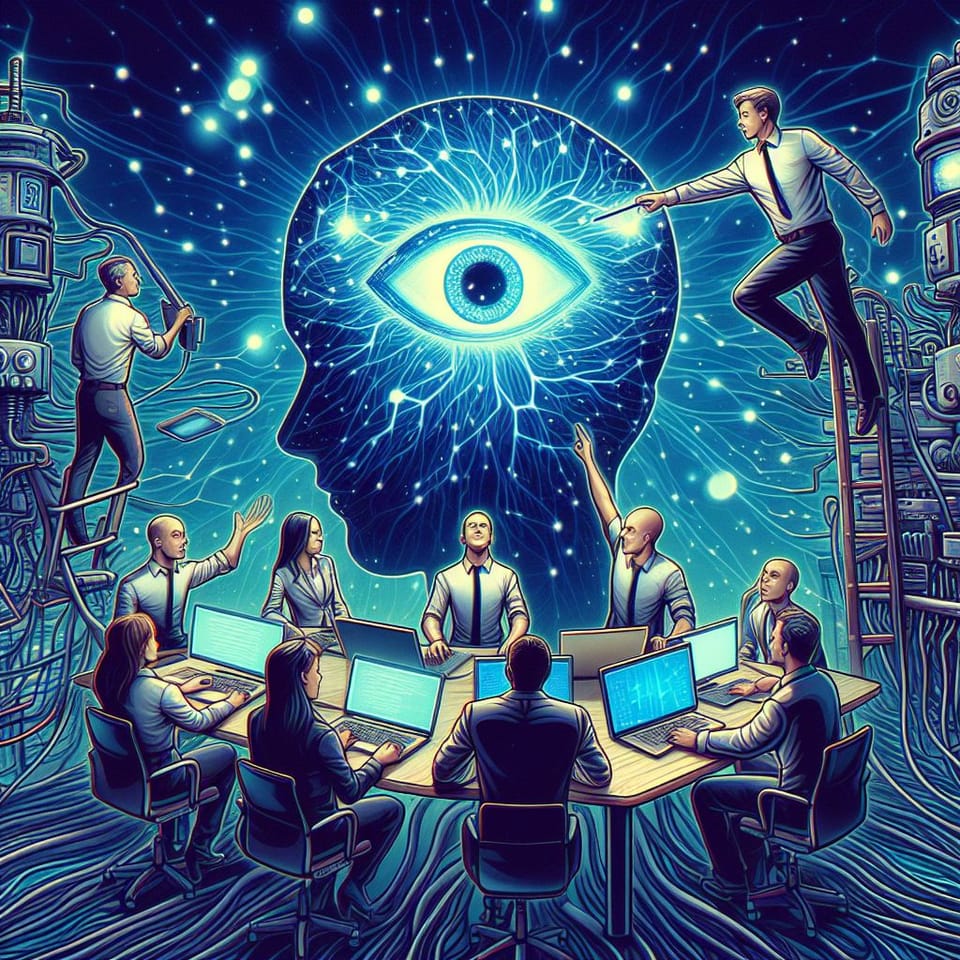
Our brains do something truly science fictions: they synchronize with one another. When you see it in EEG or fMRI data, you might first think psychic phenomena! But its "simpler" and more interesting than that. We are building models of one another, and when those models are really good, they are literally in sync with the other person. So, this week let's look at brain synchrony.
Mad Science Solves...
I have been interested in the measurement and application of interbrain synchrony for more than 10 years. In the “Research Round-Up” below I share some recent research in interbrain synchrony in classrooms and on intrabrain synchrony for health reappraisals of hard experiments. Here in the newsletter I’m just sharing a huge literature dump on you poor readers. It’s a collection of intriguing, fascinating, and occasionally downright terrifying research on interbrain synchrony across many domains.
- Caregiving & Education
- Synchronous caregiving from birth to adulthood tunes humans’ social brain
- “The amygdala, insula, temporal pole (TP), and ventromedial prefrontal cortex (VMPFC) showed high sensitivity to others’ distinct emotions. Provision of maternal–newborn contact enhanced social synchrony across development from infancy and up until adulthood.”
- Neural alignment predicts learning outcomes in students taking an introduction to computer science course
- And the papers in the Research Round-Up below.
- Synchronous caregiving from birth to adulthood tunes humans’ social brain
- Communication
- Neural signatures of attentional engagement during narratives and its consequences for event memory
- "...Self-reported engagement was synchronized across individuals and driven by the emotional content of the narratives. In functional MRI datasets collected as different individuals watched the same show or listened to the same story, engagement drove neural synchrony, such that default mode network activity was more synchronized across individuals during more engaging moments of the narratives."
- Eye contact marks the rise and fall of shared attention in conversation
- Individual differences in neuroanatomy and neurophysiology predict effects of transcranial alternating current stimulation
- Neural signatures of attentional engagement during narratives and its consequences for event memory
- Bias
- Collective Intelligence & Innovation
- Leader–follower behavioural coordination and neural synchronization during intergroup conflict
- “…during intergroup conflict…leader–follower…neural alignment [is] pivotal for groups settling conflicts in their favor.”
- And the articles in Research Round-Up below
- Leader–follower behavioural coordination and neural synchronization during intergroup conflict
- Weird
- Enhanced hippocampal theta rhythmicity and emergence of eta oscillation in virtual reality
- This isn’t interbrain, but it is cool.
- Enhanced hippocampal theta rhythmicity and emergence of eta oscillation in virtual reality
- And finally, Rats of Nym, meet the mice of Borg.
- Wireless multilateral devices for optogenetic studies of individual and social behaviors
- "Fully implantable, miniaturized devices with wireless control and power-harvesting strategies" were used to forcibly synchronize interbrain activity between mice.
- The result: "induction of interbrain neuronal synchrony in the medial prefrontal cortex shapes social interaction within groups of mice” and increases their prosocial behavior.
- Wireless multilateral devices for optogenetic studies of individual and social behaviors
Terrifying and amazing!
Stage & Screen
As an end of year treat, check out Dr. Ming's Keynote for Aberdeen's TechFest on "The Neuroscience of Trust"
We are booking dates for 2024! With engagements already secured in Paris, Stockholm, Maryland, Toronto, and more!
I would love to give a talk just for your organization on any topic: AI, neurotech, education, the Future of Creativity, the Neuroscience of Trust, The Tax on Being Different ...why I'm such a charming weirdo. If you have events, opportunities, or would be interested in hosting a dinner or other event, please reach out to my team below. - Vivienne
Research Roundup
Let’s Do a Neural Synchrony Startup
I really want to launch a project in interbrain synchrony. When 2 people engage in deep conversation, their brains literally synchronize, particularly oscillations in Temporal cortex. But interbrain synchrony can be found across many interpersonal domains, and a growing number of papers are coming out showing fascinating results, particularly in education.
One experiment recorded EEG data from 9 sets of 4 students plus a teacher. It revealed that increased synchrony between students’ brains “predicted both immediate and delayed post-test performance” on the course materials. This synchrony was highest specifically when lectures covered material that students’ later correctly answered.
Perhaps most tantalizing of all to me, the mad scientist with a passion for education, students’ learning outcomes were best predicted when their brain activity lagged “approximately 300 ms” behind the teacher’s brain activity. This means we can literally see when a student and teacher are figuratively in sync!
Imagine being able whether a team of collaborators are truly in sync, or even groups of negotiators. I have so many ideas for leveraging this (and so many dystopian scifi stories to write!)
While it might not seem relevant at first glance, it’s worth noting that the lectures and assessments used in this experiment involved factual material on “discrete topics in Biology and Chemistry”—in other words, routine memorization. I’ve previously written about synchrony in creative problem solving—are the mechanisms of interbrain synchrony the same for routine learning?
A separate study looking at Chinese high school students found differing results for “soft (Chinese)” versus “hard (Math)” material. (I’m taking “soft vs hard” as a loose mapping onto the “creative” vs “routine” divide I’ve written about many times.) The study also tracked the students for an entire semester using mobile EEG, a very mad sciency kind of experiment!
The results showed distinctly different patterns for the 2 disciplines. A student’s math scores were predicted by 4-8 Hz interbrain synchrony with the entire class, while performance in Chinese was predicted by 8-13 Hz synchrony with only the top students. Synchrony in other bands was predictive in both disciplines, but the creative-routine dimension showed a strong shift in the dominant bands. (For the nerds: it is strange that no one seems to be looking at gamma band (40+ Hz), though it wouldn’t be about precise gamma phase synchrony and more about interbrain “coupling”.)
I have a thousand ideas for application of interbrain synchrony as a measuring tool, but how can I Icarus this opportunity? What if we force synchrony between students or collaborators? There’s some intriguing mad sciency evidence in mice…but that’s for another time.
Synchronize This
I’m continuing my fascination with interbrain synchrony, the phenomenon in which the brains of 2 or more people literally synchronize. I’ve written about how interbrain synchrony predicts educational performance and innovation collaborations. How about simple cooperation and competition?
When cooperating, interbrain synchrony tracks team integration. For example, patterns of activity between brains was more similar when solving puzzles together than in isolation or when watching others solving puzzles together.
Interbrain synchrony in pilots “was close to 0 in the non-cooperative phase” but showed “dense patterns” linking “frontal and parietal areas” during the “most cooperative phases.
And how do you know which strangers will perform better together than alone? Interbrain synchrony between teammates reveals which teams will be in sync.
Interbrain synchrony isn’t only about collaboration; it plays a role in competition as well. While playing The Prisoner's Dilemma, “enhanced interbrain synchrony” between players “covaried with increased cooperative choices” and “perceived cooperativeness”. That synchrony likely means a better model of the other player and higher feelings of trust.
While decreased interbrain synchrony during The Prisoner's Dilemma predicted defector strategies even before the players defected.
What about putting your employees against each other? It turns out that competitions tend to reduce interbrain synchrony between competitors, but even during a competition, increases actually predict better cognitive performance in the players.
| Follow more of my work at | |
|---|---|
| Socos Labs | The Human Trust |
| Dionysus Health | Optoceutics |
| RFK Human Rights | GenderCool |
| Crisis Venture Studios | Inclusion Impact Index |
| Neurotech Collider Hub at UC Berkeley |
